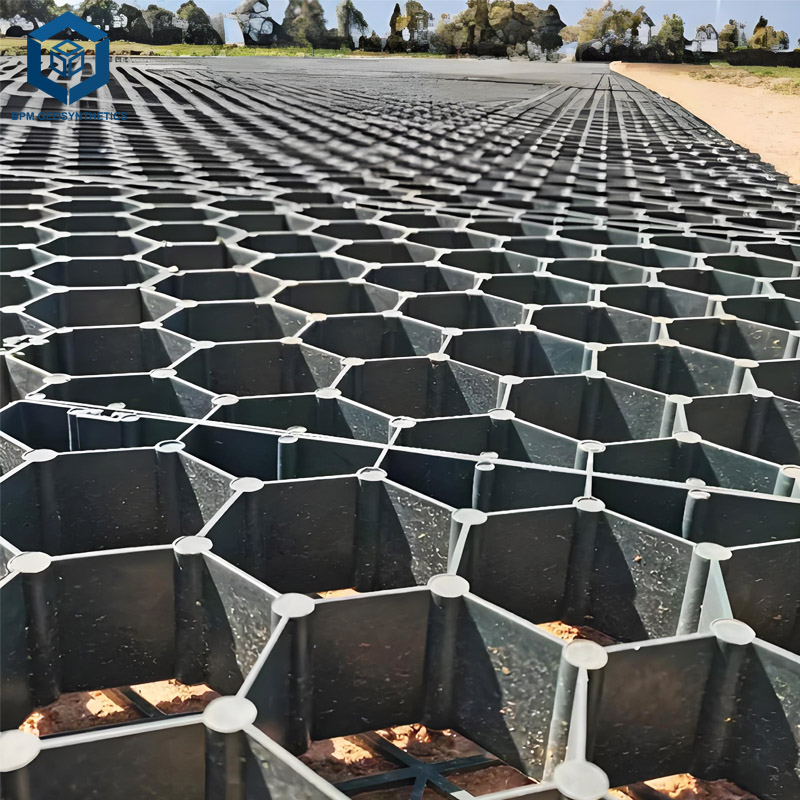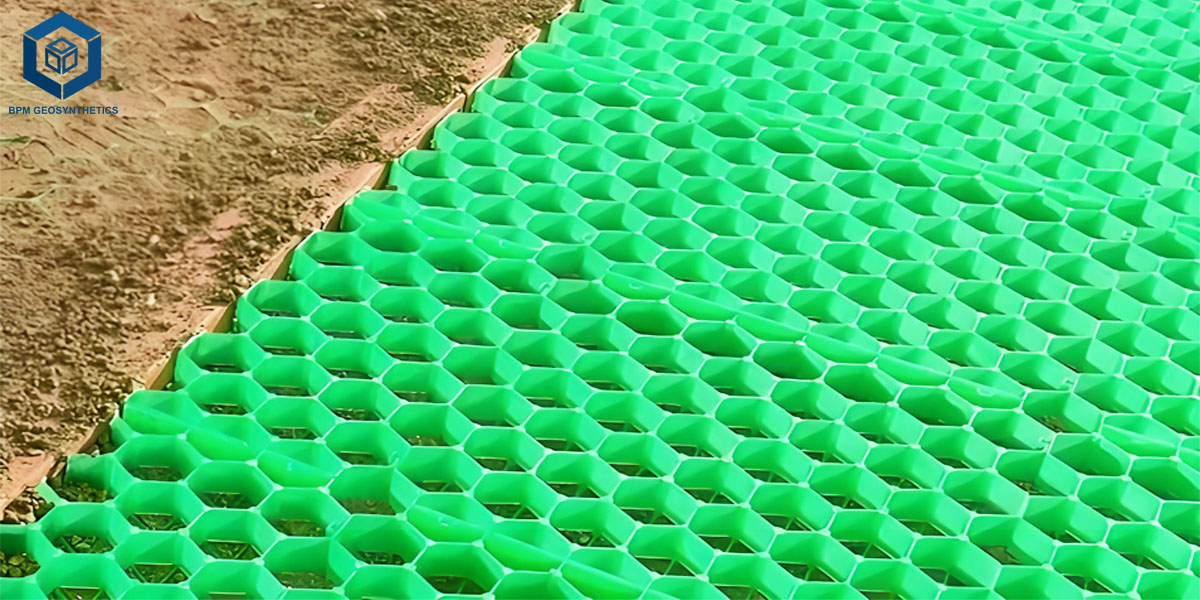Reinforced Grass Paving
Reinforced Grass Paving is a high-strength, eco-friendly ground reinforcement solution designed to support vehicle loads while maintaining a natural green appearance. Manufactured from UV-stabilized HDPE or PP, these interlocking grids stabilize soil, prevent rutting, improve drainage, and create long-lasting permeable surfaces for driveways, parking areas, fire lanes, golf pathways, and landscape projects.
- High Load-Bearing Strength: Engineered grid structure distributes loads evenly, supporting cars, trucks, and emergency vehicles without surface deformation.
- Eco-Friendly & Permeable System: Maintains natural grass growth and provides excellent water infiltration, reducing stormwater runoff and erosion.
- Anti-Rut & Soil Stabilization: Prevents sinking, shifting, or rut formation in frequently used green areas.
- Long Lifespan & UV Resistance: Made from durable materials that resist aging, cracking, and weathering.
Reinforced Grass Paving is a durable, eco-friendly ground stabilization system designed to create strong load-bearing surfaces while preserving the natural appearance of green landscapes. Made from high-density polyethylene (HDPE) or polypropylene (PP), the paving system uses an interlocking grid structure that reinforces the soil, protects root systems, and supports heavy loads without compromising grass growth. It is widely used in modern landscaping, sustainable construction, green parking areas, and stormwater management projects.
1. Reinforced Grass Paving Product Structure & Material Composition
1.1 High-Strength Plastic Grid System
Reinforced Grass Paving consists of modular panels formed into a honeycomb or lattice-style grid. These grass paving is engineered to maintain consistent structural integrity, even on uneven or soft soil conditions.
1.1.1 Distribute loads evenly across the surface
The interconnected grid cells spread vehicle pressure over a larger ground area, reducing the risk of localized soil compression. This improves long-term stability and ensures the surface remains functional under both light and heavy traffic.
1.1.2 Provide a stable base for soil and grass
The grid walls confine the soil within each cell, preventing displacement and promoting healthy root development. This structure encourages uniform grass growth and maintains surface flatness even in high-use areas.
1.1.3 Prevent surface deformation and rutting
By holding the soil firmly in place, the grid eliminates common issues such as sinking, rut formation, and surface waves. This ensures a smooth, clean appearance and reduces costly repairs or frequent lawn maintenance.
1.2 Premium-Grade Materials
1.2.1 HDPE: Offers high impact resistance, flexibility, and long-term durability
HDPE adapts well to ground movement and temperature changes, preventing cracks or breakage. Its resilience allows the paving system to handle repeated vehicle loads without losing strength.
1.2.2 PP: Provides excellent stiffness and strength for heavy-load applications
PP enhances the overall rigidity of the grid, making it ideal for industrial or emergency-access surfaces. It maintains structural stability even under dynamic loading or shifting sub-base conditions.
1.2.3 UV-stabilized additives prevent degradation from sunlight exposure
These additives protect the plastic from brittleness and color fading caused by long-term UV radiation. As a result, the paving system maintains its mechanical properties and clean visual appearance for many years.
1.2.4 Non-toxic, environmentally safe materials suitable for green infrastructure
The materials do not leach harmful chemicals into the soil, making them suitable for parks, gardens, and ecological landscapes. They support environmentally sustainable design by integrating natural vegetation with reinforced ground systems.
The combination of advanced material performance and intelligent grid design ensures long-lasting service life, even under continuous vehicle movement or challenging climate conditions.
2. Functional Advantages & Engineering Benefits
2.1 Load-Bearing Reinforcement
The cellular structure effectively transfers vertical pressure to the sub-base, allowing the surface to support:
- Cars, SUVs, and light trucks
- Fire trucks and emergency vehicles
- Heavy maintenance equipment
This reinforcement prevents turf compaction and surface collapse.
2.2 Natural Grass Protection & Healthy Growth
Each grid cell retains soil, supports root development, and protects grass from wheel pressure. Benefits include:
- Stable root zone and increased oxygen flow
- Less soil displacement during rain
- Uniform grass coverage
- Reduced maintenance compared to traditional lawns
2.3 Superior Drainage & Water Permeability
The open-cell design enables excellent water infiltration, helping to:
- Reduce stormwater runoff
- Prevent water pooling and erosion
- Increase groundwater recharge
- Achieve compliance with sustainable drainage (SuDS) standards
2.4 Anti-Rut & Anti-Sink Performance
Reinforced Grass Paving locks the soil in place, preventing:
- Deep ruts from vehicle movement
- Soil erosion caused by rainfall
- Surface instability on slopes or soft soil
2.5 Long-Term Weather Resistance
Thanks to UV-resistant stabilizers and robust polymer structure, the paving maintains performance under:
- Extreme temperatures
- Direct sunlight
- Humidity and freeze–thaw cycles
3. Reinforced Grass Paving Applications Across Industries
Reinforced Grass Paver is widely used in professional construction, landscaping, and public infrastructure projects due to its ability to support heavy loads while maintaining a natural green appearance. Its versatility makes it suitable for both small residential improvements and large-scale commercial or municipal developments.
3.1 Green Traffic & Parking Areas
3.1.1 Residential driveways
Grass pavers driveway provides a strong yet natural-looking driveway surface that blends seamlessly into garden landscapes. Homeowners benefit from reduced runoff and a cooler surface compared with traditional concrete or asphalt.
3.1.2 Overflow and temporary parking
These grids allow large areas to be prepared quickly and efficiently for high-volume parking needs. After events, the green surface recovers easily and remains visually appealing for future use.
3.1.3 Office and commercial parking lots
Businesses use reinforced grass paving to meet green building requirements and improve site aesthetics. It also helps lower heat island effects around commercial buildings.
3.1.4 RV parking zones
The system supports heavy RV loads without causing depressions or soil damage. It creates a stable platform that remains passable year-round, even in wet conditions.
3.1.5 Event or stadium green parking
Perfect for venues needing durable surfaces that can handle seasonal or weekend crowds. After heavy use, the reinforced turf remains intact, reducing maintenance costs for facility managers.
3.2 Landscape Architecture & Garden Projects
3.2.1 Garden walkways
These grids maintain the natural look of a green garden path while preventing soil displacement. They create a clean walking surface that stays stable during rain.
3.2.2 Lawn reinforcement
Reinforced paving protects grass areas frequently used by pedestrians or lawn equipment. It keeps the lawn surface even and healthy, minimizing bare patches.
3.2.3 Backyard access routes
Ideal for paths used by wheelbarrows, garden tools, or small vehicles. The system strengthens the soil, ensuring the route remains firm without damaging the lawn.
3.2.4 Footpaths in parks
Parks benefit from durable pathways that remain green and pleasant for visitors. The surface stays erosion-resistant, even with high foot traffic and varying weather conditions.
3.3 Recreation & Sports Areas
3.3.1 Golf cart paths
Provides stable travel routes while blending naturally with the surrounding greens. It prevents rutting from repeated cart movement and keeps turf healthy.
3.3.2 Sports field access routes
Allows maintenance vehicles to reach fields without damaging the playing surface. The pavers with grass remains stable under weight and frequent travel.
3.3.3 Turf reinforcement around playgrounds
Helps protect grass in areas where children frequently run or play. The grid supports safe, soft surfaces while preventing erosion and muddy patches.
3.4 Environmental & Civil Engineering
3.4.1 Slope stabilization
The grid strengthens soil structure, reducing the risk of landslides or erosion on sloped terrain. It also supports vegetation growth for long-term environmental protection.
3.4.2 Erosion control areas
Reinforced paving prevents soil from washing away during heavy rain or flooding. It enhances drainage and keeps the surface intact even in harsh weather.
3.4.3 Fire access lanes
Provides a load-bearing route for emergency vehicles while maintaining the natural landscape. Municipalities often use it to meet fire-code access requirements in green zones.
3.4.4 Helicopter landing zones
Ensures a stable and level surface that can withstand downwash forces from helicopter operations. The grid prevents soil scattering and maintains structural integrity after repeated landings.
3.4.5 Pipeline or utility maintenance paths
Creates durable access routes for maintenance personnel and equipment. These surfaces stay firm in all weather conditions, reducing repair delays and improving safety.
4. Reinforced Grass Paving Installation Guide & Construction Steps
Step 1: Ground Preparation
Excavate the area to required depth
This ensures enough space for the base layers and creates a stable foundation for long-term performance.
Level the surface and compact the soil
Proper compaction minimizes settling and keeps the reinforced surface even after years of use.
Install a geotextile layer to separate soil from the base
The geotextile prevents mixing of layers, improving drainage and extending the lifespan of the system.
Step 2: Base Layer Construction
Add a crushed stone or gravel sub-base
This layer provides essential structural support and enhances overall load distribution.
Compact thoroughly to required density
Well-compacted material prevents shifting under traffic and maintains a firm, stable surface.
Adjust thickness depending on expected load
Heavier applications such as parking areas or fire lanes require deeper bases to ensure durability.
Step 3: Panel Laying & Interlocking
Place lawn driveway pavers panels on the surface
Ensure panels are aligned correctly to maintain a uniform grid pattern.
Use interlocking features to connect adjacent grids
The secure connections prevent panels from separating under movement or load.
Secure edges to prevent movement
Edge restraints keep the entire installation locked in place and improve overall stability.
Step 4: Infill Placement
Fill cells with a mixture of soil, sand, and organic material
This blend provides optimal drainage while supporting healthy grass growth.
Level off to ensure cells are fully filled
Proper leveling prevents low spots and ensures the surface remains even after compaction.
Seed or lay turf over the filled grid
Grass quickly integrates with the structure, creating a reinforced yet natural-looking surface.
Step 5: Watering & Root Establishment
Water to support seed germination
Adequate moisture helps the soil settle and promotes fast, uniform grass growth.
Allow grass to root through the cells before heavy traffic begins
Fully established roots ensure the surface can withstand repeated vehicle or foot loads without damage.
5. Reinforced Grass Paving Technical Specifications
While specifications can be customized, typical parameters include:
- Panel Size: 400–600 mm per piece
- Cell Height: 30–50 mm
- Load Capacity: 120–450 tons/m² depending on thickness
- Material: PE or PP
- Color Options: Green, black, grey
- Service Life: 10–20+ years
Customization includes panel size, wall thickness, color, and connection design according to project requirements.
6. Reasons for Choosing Reinforced Grass Paving
- Combines performance with aesthetics
- Provides natural, environmentally friendly ground reinforcement
- Reduces construction cost compared to concrete or asphalt
- Helps meet green building and low-impact development standards
- Ideal for areas requiring occasional or continuous traffic while preserving greenery
Summary
Reinforced Grass Paving provides durable, eco-friendly ground reinforcement while maintaining a natural green look. Ideal for driveways, parking areas, parks, and sports paths, it combines strength, drainage, and long-lasting performance. For reliable quality and professional support, The Best Project Material Co., Ltd.(BPM Geosynthetics)is your trusted choice.











